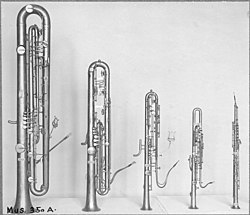This article needs additional citations for verification. (February 2009) |
 Sarrusophones, left to right: bass, baritone, tenor, alto, soprano. Metropolitan Museum of Art, New York | |
| Woodwind instrument | |
|---|---|
| Classification | |
| Hornbostel–Sachs classification | 422.112 (Double reed aerophone with keys) |
| Inventor(s) |
|
| Developed | Mid 19th century |
| Playing range | |
 | |
| Related instruments | |
| Builders | |
| |
| More articles or information | |
| Sarrusophones: | |
The sarrusophones are a family of metal double reed conical bore woodwind instruments patented and first manufactured by French instrument maker Pierre-Louis Gautrot in 1856. Gautrot named the sarrusophone after French bandmaster Pierre-Auguste Sarrus (1813–1876), whom he credited with the concept of the instrument, though it is not clear whether Sarrus benefited financially. The instruments were intended for military bands, to serve as replacements for oboes and bassoons which at the time lacked the carrying power required for outdoor marching music. Although originally designed as double-reed instruments, single-reed mouthpieces were later developed for use with the larger bass and contrabass sarrusophones.